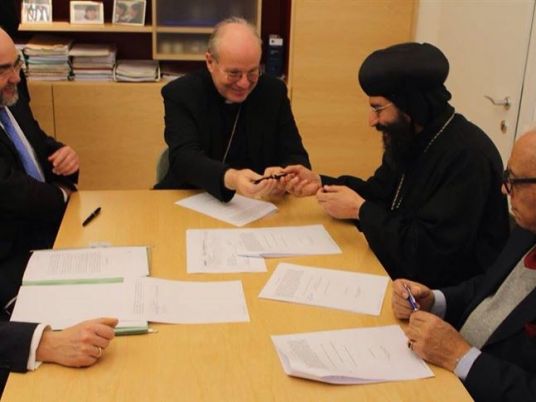
There is a lot of art on the Internet. Most newly created art, no matter who makes it or where it is, will eventually find itself reproduced and represented in digital space — a document of an object that exists in the real world.
But artist and musician Kareem Lotfy is interested in this evidence as something more, as the thing itself. “I always saw online documentations more than real shows,” Lotfy says.
And when online documentation is so much more present than the physical spaces and objects being documented, the real things begin to fade into irrelevancy. The question arises of why what an image represents is more important than the image itself, as it exists online.
“You start developing senses toward the perception of things on a screen. You start loving seeing it through this light and pixels and texts around it,” Lotfy says.
This appreciation for the aesthetics of the digital environment informs not simply the work Lotfy creates, but also how he presents it online. Many young artists today use the Internet as a calling card, creating websites to clearly showcase their work.
But Lotfy’s online self-representation is more diffuse. Rather than fighting the scatterbrained, visual over-stimulation of digital space, he embraces it and allows his work to swim in it.
Lotfy produces both images and music prolifically, but on his Tumblr page, you will find his work dispersed among other found images and sounds. His website changes regularly, but presents only one image or video at a time, sometimes his work and sometimes the work of someone else. He encounters the Internet as space and material, and mixes his artwork into this space, allowing it to constantly shift and disappear — to be absorbed into the ephemeral, changeable pixels and bits that compose it.
Lotfy studied sculpture at the Alexandria University Faculty of Fine Arts, and although he may have mostly left physical objects behind, he approaches digital space with a sculptor’s sensitivity. He is still interested in shaping material, but the nature of that material has changed.
The images he creates tangle the lines between reality and the representation of reality. This relationship is exemplified in an image Lotfy created a year ago: a simple line drawing, suspended in a gallery, casting shadows on a wall, hanging as an almost-presence in an almost-real space.
The image was created by scanning and editing a bamboo-and-ink drawing. When encountered online, it becomes documentation of an impossible work of art. There is no way to know whether it is an illusion, a Photoshop creation, or something “real.” As the boundary between image and document fades, the distinction itself becomes unimportant.
This play with imagined installation images and virtual exhibitions is integral to the way Lotfy shows his work. Although he lives in Cairo, Lotfy is as likely to exhibit in Switzerland or the Netherlands as in Egypt. After a residency in Amsterdam in 2010, he met a group of artists who shared his interests and with whom it was as easy to interact and collaborate via the Internet as in real life.
Most of these artists are based in Europe, and since 2010, several have gone on to create actual small galleries to show artwork. But Lotfy remains here, and he remains online. “I still exist in the air, as this guy in Egypt,” he says.
His most recent exhibition, “Tribal House,” which opened in late May at Headquarters in Zurich, Switzerland, plays with this relationship and emphasizes his abstract presence as an artist from a distant, exotic location, while turning all sense of space and object, digital or real, on its head.
Headquarters is a small gallery showcasing work that merges physical and virtual space. Appropriately, the work that eventually became “Tribal House” went through multiple processes of translation from object to image to object and back again. It began with Lotfy shaping small, African-influenced, generically tribal masks out of clay. The creations came, according to Lotfy, from a reticent impulse toward traditional sculpture left over from his days in the Faculty of Fine Arts.
Lotfy photographed the masks and edited the digital images so that the photographed objects appeared as 3-D simulations. He began making images, placing the digital masks in living rooms and bathrooms and gardens so that they hang as strange, looming non-presences, awkwardly filling up mundane spaces.
For the Headquarters exhibition, Lotfy simply sent the images to his friends at the gallery. They printed them out and pasted them on to large wooden panels, then placed them in various settings around the space.
In photographs, the resulting exhibition appears no more real than the digital images Lotfy originally created. The masks hover uncomfortably, appearing too large and too flat to be real, creating the illusion of an illusion.
Although the exhibition actually took place, it nonetheless exists as comfortably online as offline. For Lotfy, who did not go to Switzerland to see the installed work, and for most people who will encounter it, the exhibition itself becomes simply an elaborate act of image creation.
But for all of Lotfy’s manic exploration of the visual, virtual space, and all of the tricks and illusions his work engages in, there is an aspect of his artistic interest that is purely sensual, based on beautiful textures, images and sounds.
Engaging as he does in a hyperactive intake of digital media of all kinds, Lotfy suffers from the all-too-common 21st-century affliction of image fatigue. “There are too many visuals, and people deal with it as an information tool,” he says.
Both in his work as a visual artist and a musician, Lotfy attempts to find the sensual essence of image and sound. His music, which he performed recently in Cairo at the 100 Live Music Festival and which is accessible online, displays a deep appreciation for the resonances of the physical world — saxophones, drums hit with human hands, echoes, bird sounds and buzzing strings. Lotfy weaves together all these sounds, combining them with digital rhythms and textures to create short pieces that come together and disappear like momentary pictures. There is no question of whether the music is there. As Lotfy points out, it is simply not actually there, and the question of representation or reality never comes up.
This sensitivity to specific media is also expressed in Lotfy’s visual art. Amid all his other work, over the past year he has been creating digital tapestries: undulating black-and-white GIFs based on patterns from real woven fabrics. In December, Lotfy exhibited a number of these shimmering blankets of pixels as part of the “d1sc0nN3ct” exhibition at Townhouse Gallery of contemporary art.
Again, the installation of the work engaged in a complicated translation of the digital into the physical. But in this case, rather than playing perceptual games, the patterns projected on the Townhouse factory wall appeared simply as shimmering, textural objects — no longer images not meant to reside in virtual reality or physical reality alone, but simply pure expressions of the aesthetic possibilities of digital material.
This piece was originally published in Egypt Independent's weekly print edition.






